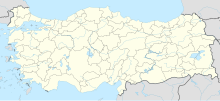Harput
Coordinates: 38 ° 42 ' N , 39 ° 15' E
Harput ( Armenian Խարբերդ Charpert ) is an important ancient city in the Turkish province of Elazığ . Due to the expansion of Elazığ , Harput lost its importance from the 19th century. Harput is rich in structures such as a fortress, mosques and other buildings. Harput is thus like an open-air museum and is now the destination of tourists and residents of Elazığ looking for relaxation.
history
Harput's settlement dates back to the third millennium BC. BC back. The oldest inhabitants are the Hurrites , who were soon replaced by the Hittites . After the collapse of the Hittite Empire, Harput came under the rule of the Urartians . Various empires and peoples settled in Harput over time. So the Persians , the Romans , the Byzantines . With the arrival of the Turkish nomads in Anatolia , Harput fell to the Turks in 1085. At first Harput was part of the Beylik of the Çubukoğulları , later of the Beylik of the Ortoqids . Furthermore, the Ilkhan , the Beylik of the Dulkadir , the Aq Qoyunlu , the Safavids and from 1516 the Ottomans ruled Harput . Harput was always an important place and later the capital of an Ottoman vilayet , including the Vilâyet Mamuretül-Aziz . The Harput massacre took place here in 1915 .
Due to its bad terrain with many streams, gorges and missing plains, Harput could not really grow. Therefore, the administrative center was moved to Elazığ, which was on one level.
Attractions
Fortresses
The Harput Fortress, also called Milk Fortress ( Süt Kalesi ), is located in the southeast of the city and towers over the valley. The fortress was built by the Urartians and later restored and restored by the Romans, Byzantines and Arabs . The fortress consists of an inner and an outer castle.
Mosques
- Ulu Cami, the Great Mosque was built by the Ortoqid ruler Fahrettin Karaslan between 1156 and 1157. It is one of the oldest and most important mosques in Anatolia.
- The Kurşunlu Cami is one of the most beautiful Ottoman mosques.
- Ağa Camii is to the left of the main street in Harput. Its dome has collapsed and only one minaret remains. It is said to have been built by Pervane Ağa in 1559 .
- Alacalı Cami, Artukidian mosque from the beginning of the 13th century.
Churches
- Meryem Ana Kilisesi: The Church of the Blessed Mother Mary is near the fortress. The back wall of the church leans against the rock on which the fortress stands and therefore looks like its extension. It was built in 1179 and is also known as Kızıl Kilise (Red Church), Süryani Kilisesi (Aramaic Church) and Yakubi Kilisesi (Jacobin Church).
- Until the First World War there were four Armenian Apostolic Churches in Harput : Surp Hagop, Surp Garabed, Surp Istepanos and Surp Nschan.
caves
Buzluk Mağarası (Ice Cave) is located four kilometers from the city of Harput . The cave has a cool climate in summer and warm in winter. In the past, residents of the surrounding villages often hid their food in this cave. Caravans used to use the Deve Mağarası (camel cave), six kilometers from Harput in a valley, as a resting place, which is what gave it its name.
Museums
The Harput Museum contains finds from the city and the surrounding area. It has been closed since 2003 and will reopen as a cultural center after renovation.
various
The Austrian botanist Franz Joseph Freyn (1845–1903) named a white flowering wild leek species that occurs in eastern Turkey and Iran ( Allium kharputense ) after the city. Other endemic species of the region also bear the name of the city, also written as Harput ( Alyssum harputicum ), Karput ( Astragalus karputanus ) or Charput ( Verbascum charputense Murb.).
Personalities born here
- Sahag II. Khabayan (1849–1939), Catholicos of the Great House of Cilicia
- Ashour Yousef (1858–1915), professor, journalist and victim of the genocide of the Aramaeans
- Karekin Deveciyan (1867 or 1868–1964), functionary
- Shahan Natali (1884–1983), politician and writer
- Fuat Sanaç (* 1954), President of the Islamic Faith Community in Austria (IGGiÖ)
Web links
Individual evidence
- ↑ Pars Tuğlacı : Tarih boyunca Batı Ermenileri tarihi. Cilt 3. ( 1891-1922 ) , Pars Yayın ve Tic., Istanbul and Ankara 2004 ISBN 9757423068 , page 274
- ↑ Uğur Çakılcıoğlu, Şemsettin Civelek 2007, Some uncommon and endemic Plants of Harput (Elazığ). Doğu Anadolu Bölgesi Araştırmaları 2007, pp. 48–54.



